Zotac's Ion: The World's First mini-ITX Ion Board
by Anand Lal Shimpi on May 12, 2009 12:00 AM EST- Posted in
- GPUs
The Zotac Ion is available as a mini-ITX motherboard alone. Mini-ITX will work in ATX, micro-ATX, and mini-ITX cases.
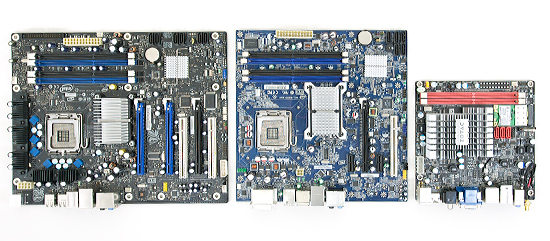
From left to right (ATX, micro-ATX and mini-ITX)
There are two versions of Zotac’s Ion, the ION-ITX-A-U and the ION-ITX-B-E. The more expensive “A” model ships with a dual-core Atom 330 processor, a mini-PCIe WiFi card and an external DC power supply. The “B” model comes with a single-core Atom 230 processor, no WiFi and requires a standard power supply. They are priced at $189 and $139, respectively, from etailers. Add another $10 for retail pricing. Update: Zotac just informed me of two additional versions coming: a C and a D version. The C version will be a single-core product with the DC power supply and the D version will be a dual-core product with no power supply.
Availability will be in limited quantities starting this week. Zotac hopes to have more widespread availability by June.
The first change compared to Intel’s desktop Atom boards is that the Zotac board is entirely passively cooled. While Zotac ships a fan in the box, it’s optional to use. Granted the heatsink on the Zotac Ion is huge, inevitably adding more cost to the board but I’d take that over a spinning fan; the Zotac Ion is completely silent.

The optional fan
Zotac gives us two DDR2 DIMM slots (4GB max total memory) instead of one on the Intel boards, and it supports up to DDR2-800 memory. While Zotac could’ve opted for DDR3 slots, DDR2 seems like a safer bet since you’re more likely to have spare DDR2 memory laying around these days (especially after you make that upgrade to Phenom II or Core i7).

Oooo, expansion
We get three SATA ports instead of two, but no PATA ports. There’s no PCI slot but you do get a mini-PCIe slot for an optional WiFi card.
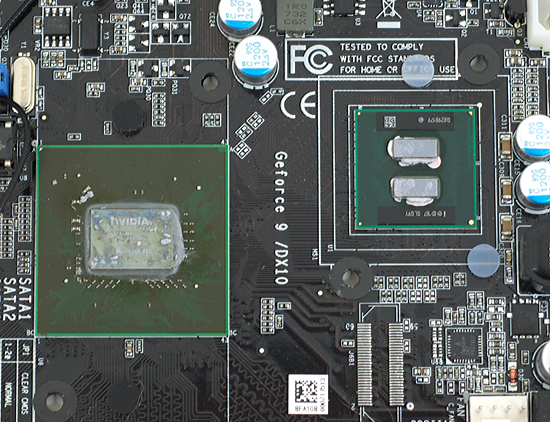
The GeForce 9300, the heart of NVIDIA's Ion platform
On the rear Zotac outfitted the world’s first mini-ITX board with every port you could possibly want. For display output you get everything that matters: VGA, DVI and HDMI. You’ve got three ways of getting audio out of the board: analog, optical or coaxial digital.
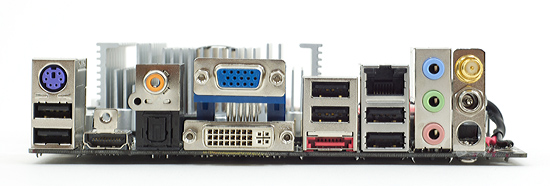
Now that's more like it
There are six, count em, six USB 2.0 ports - up from the four on the Intel boards, a single Gigabit Ethernet port (just like on the Intel D945GCLF2), eSATA and a PS2 port. I believe the only feature advantage Intel holds is that its Atom boards have two PS2 ports, one for keyboard and one for a mouse, while the Zotac board only has a keyboard port.
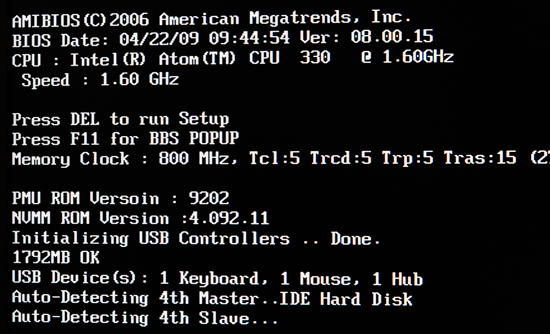
Zotac's POST screen. Spot the spelling error and embarrass Zotac for 15 points.
Assuming you have a USB mouse, Zotac wins hands down in the feature comparison and that’s without giving it extra points for having a way more capable graphics core than the D945GCLF2. I don’t think I’d change a single thing on the Zotac Ion; it’s possibly the manliest Atom motherboard on the market. *grunt*
Unique to the dual-core model I tested is an external DC power supply. The board has no ATX power supply connector on it, instead it relies on an external 90W power brick similar to what you’d get with a large notebook.
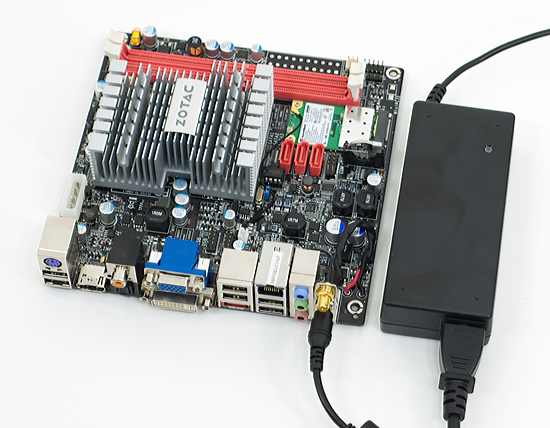
Powah
Just plug the power brick into the I/O panel of the motherboard and you’re good to go. Zotac was careful to put the DC input on the rear of the motherboard so it can still be used in any ITX case, even ones with an internal power supply.
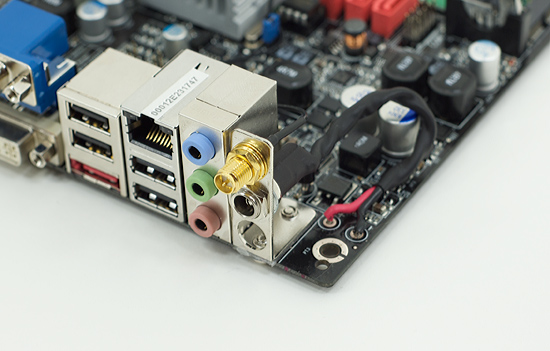
Plug the power brick into the rear panel underneath the WiFi antenna.
There’s a single 5-pin molex connector on the motherboard that can be used to power your SATA drives. Zotac ships the motherboard with a cable that provides three SATA power connectors off of the one on-board molex connector. Given that the board only has 3 SATA ports on it, the 3 power connectors should suffice. Note that they are only SATA power connectors, if you have older drives you’ll need a different cable.
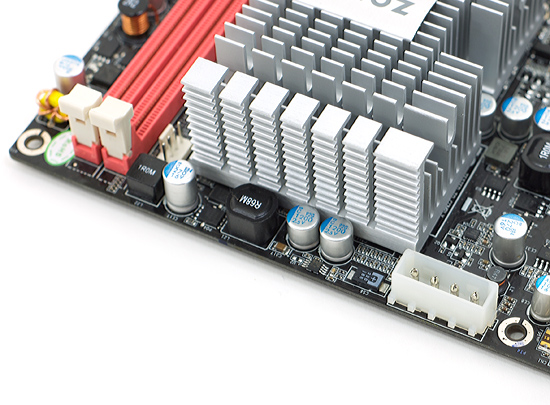
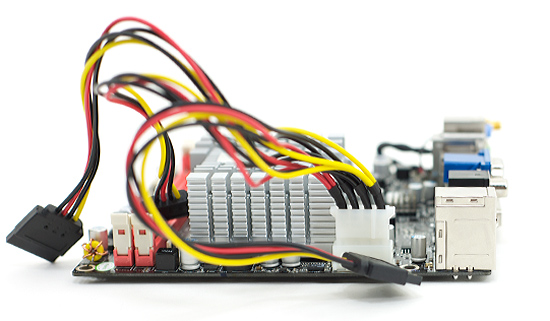
The external power supply is nice to have. It simplifies the construction of your system greatly. You can take the board and pretty much just set it anywhere you want. It’s passively cooled so you don’t need to worry about dust, just don’t put it on anything that conducts electricity.
The only issue I have with the external power supply is that it’s not as easy to replace as a standard ATX power supply. The brick is made by Delta and you might be able to find something with similar specs online, otherwise you’re left asking Zotac for another should something happen to yours.










93 Comments
View All Comments
scottwilkins - Tuesday, May 19, 2009 - link
I need a ITX with PCI-e 1x slot. ANyone seen such an animal?dingetje - Tuesday, May 12, 2009 - link
@Pandamonium,No it was not rude; flipmode was obviously joking about the funny sounding line in the article.
Lighten up...
flipmode - Tuesday, May 12, 2009 - link
Yeah, it did sound pretty rude, but I was just giving him a hard time.Anand Lal Shimpi - Tuesday, May 12, 2009 - link
I didn't intend for the line to sound like that, I meant that after our first review went up there was a great amount of interest in an Ion motherboard from our readership. I'll update to clarify.I stuck with the x264 test for power consumption since we've used it in previous reviews and I needed a good way of comparing power consumption to other systems that can't play back Blu-ray content.
Take care,
Anand
flipmode - Tuesday, May 12, 2009 - link
I did not mean to sound too snotty, but I do enjoy being a smart ass once in a while. Maybe a :wink: would have been better than a :roll:As for power consumption, using x264 encoding does make sense for most reviews, but it seems a bit of stretch for this one. I sure do feel bad for anyone encoding x264 with an Atom. Do you think it is safe to say that the power consumption would be at its highest when the IGP is under load?
Anand Lal Shimpi - Tuesday, May 12, 2009 - link
I agree, in hindsight I should've probably done a load test with the GPU being stressed as well. I'll try and look at that if I do a followup.The power consumption of the Ion/GF9300 chipset should be higher than the dual-core Atom CPU, so anything that stresses the GPU should deliver the highest power consumption. Note that Blu-ray playback uses the PureVideo HD engine which is actually separate from the shader processors on the GPU, it's a separate set of functional blocks on the die. I wouldn't assume that BD playback would generate the highest power consumption values, playing a game might do the trick for that.
Take care,
Anand
yyrkoon - Wednesday, May 13, 2009 - link
Anand, Thanks much for the review. I have been wondering much about this platform since I first read the ads on nVidias webpages.Here, we live off grid, and are entirely powered by solar + wind (and the occasional running of a 30kW gen to pump water). What I was hoping to see here, was something that could play games fairly well at medium settings, do photoshop tasks fairly well, and play movies well also. I was fairly certain the latter would not be much of a problem, but the former two might have been. According to your benchmarks, it looks like my guess was not too far off.
Also, your review came about two days too late concerning a decisions I was making concerning getting a newer system for above duties, while keeping power usage down to a minimum. That however is not your fault, and probably made my decision much easier.
Now, I would like to add that the Zotac board with ATX power connectors is it ? May actually be a better overall option for some, including myself, *if* "we" can find a good sub 100W 80 Plus PSU. Once you get down to around 50-60W of system usage, the 50% PSU power out/usage combination is what can, and does kill power efficiency according to what I have been reading(e.g. for best efficiency, loading any PSU is usually optimal at 50% load capacity). George Oui from ZDNET tech articles (sorry may have spelled his last name incorrectly, I do not have the link handy) has done some experimentation on the subject, and at the time of his findings the best PSU he was able to find was the sparkle 220W 80 Plus PSU ( the PicoPSU's did not seem to do as well ). Anyways, he was able to get a complete Core 2 system, including an LCD monitor down to a sipping 49W of power usage while under load I believe. Personally, I consider that pretty good.
Anyways, thanks again, and I for one would love to see more articles along these lines.
Penti - Friday, May 29, 2009 - link
Why not simply run something downclocked? Low-power parts or simply a laptop with a discrete GPU is also a possibility. Or even something like the Fujitsu Amilo Sa 3650 with graphic booster (external mobile HD3870).BTW the Zotac board comes with a powersupply and doesn't have an ATX connector in this version Anand reviewed.
strikeback03 - Thursday, May 14, 2009 - link
The Pico-PSU efficiency is going to be rather dependent on the efficiency of your AC to DC conversion. They claim over 95% DC-DC efficiency, so if you have an efficient method of directly feeding them regulated 12V they probably do pretty well. I suppose if you needed multiple workstations you could use one ATX PSU to feed regulated 12V to a bunch of Pico-PSUs and get the load on the ATX PSU up to the range it likes. Otherwise, I'm not sure how efficient those bricks are at Ac to DC.therealnickdanger - Wednesday, May 13, 2009 - link
Great review, thanks!Speaking of GPU tests, I have seen other reviews of Ion showing Left 4 Dead playable at 25fps and WoW (720p, low details) playable at 50fps! How come your rates are so low?
I think it would be appropriate to follow up with testing of games like UT2004, Halo PC, COD4, Battlefield 2, and Counter-Strike: Source. Obviously, Crysis would be a waste of time on this platform, but some slightly older games that are still played heavily online and at LAN parties are ones I would really like to see benched.
Nothing would excite me more than to have a portable, cheap, fanless, low-power, Mini-ITX gaming machine for some of the games listed above. If it can manage 25-30fps at or near 720p without looking like a turd, that would be more than acceptable. Please don't make me buy one and benchmark it myself! ;-)